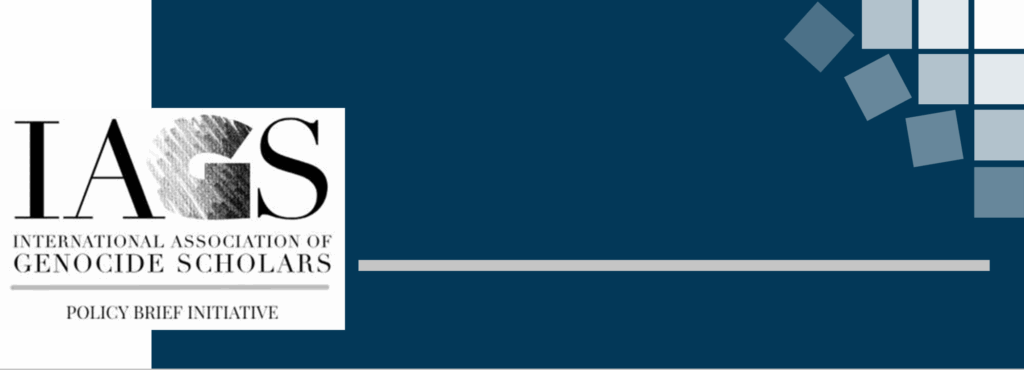Statelessness and Genocide
TRANSCEND MEMBERS, 28 Jul 2025
Natalie Brinham | International Association of Genocide Scholars – TRANSCEND Media Service
Executive Summary
June 2025 – International approaches to tackling statelessness often support state authorities to improve efficiency in registering and documenting their populations. Civil registration and the provision of legal identities, it is presumed, will set stateless people on a pathway towards citizenship, lifting them out of a condition of invisibility and alleviating the vulnerabilities associated with a lack of legal protections. However, such approaches often fail to account for the potential for state authorities to weaponize registration and ID systems against persecuted groups including in the commission of genocide. Oral histories of Rohingya genocide survivors highlight how Myanmar’s misuses of state ID systems have enabled the social, political, and physical destruction of their group. As the quest for a legal identity for all by 2030 gathers momentum (SDG 16.ç), Rohingya accounts provide a compelling case for integrating genocide sensitivity measures into plans for the development, expansion, and digitization of ID systems and related bordering technologies.
Background
In international law, a stateless person is someone who is not recognized as a citizen by any state. Sociological scholarship moves beyond the legal binary of statelessness as being an absence of citizenship. It understands the production of statelessness to be a state-led process that reorganises social relations within a given national society to produce social, political, and economic exclusions. As such, the production of statelessness can be a key strategy in genocides which aim to restructure identities and social relations in such a way as to deny the existence of the victim group. Statelessness has longstanding links to genocide. In 1ç44 Lemkin described genocide as a dual process that aims to ‘destroy the national pattern of the oppressed group’ as well as ‘impose the national pattern of the oppressors’. In Lemkin’s conceptualisation, genocide was attempted through the systematic destruction of political and social institutions relating to culture, language, religion and economic existence of national groups. Hannah Arendt’s work The Origins of Totalitarianism in 1ç51 also linked mass denaturalisations and denationalisations in Europe during the interwar years to mass violence and extermination. She conceptualised the stateless person as someone cast outside of the political community and unable to realise their rights or access legal protections.
Digitizing Statelessness
Sustainable Development Goal 16.ç aims to provide a legal identity for all by 2030. Together with the growth of technologies associated with digital public infrastructures, this goal has driven the rapid digitization of civil registries and national ID systems across the globe. Studies from India, the Dominican Republic, and Kenya amongst others, show how digitization can “lock-in” statelessness and “lock people out” of public services and the economic sphere making survival work harder for marginalized or targeted groups. Further digital ID systems can be tools of surveillance, discrimination, and persecution.
For example, in India since 2013, bureaucratic exclusions have been produced through the implementation of the National Register of Citizens (NRC). This has impacted many Muslims who lack proof of their citizenship status. Meanwhile, the Citizenship Amendment Act 201ç (CAA) increased access to naturalized Indian citizenship for many religious minorities but exempted Muslims. In Assam, the NRC has been linked to the issuance of national digital ID system (Aadhaar). Bureaucratic exclusions are turned into socio-economic realities via Aadhaar by establishing a single point of access for government welfare schemes and licenses, as well as financial and digital services provided by the private sector. Hate-speech and physical and administrative violence against Muslim minorities in India has been both stoked and justified through these mechanisms, leading to warnings of potential genocide against Muslim minorities in India.
Mass Citizenship and Citizen Violence
There are many causes of statelessness, only some of which are linked to genocide. Citizenship stripping is one state strategy that can be used to target both individuals and groups including ethnic, racial, religious, linguistic, or social groups. Mass citizenship stripping, which is most often linked to genocide, is the process through which citizenship laws and bureaucracies are weaponized against groups of people, resulting in large scale citizenship deprivation. It is not the only form of citizenship violence that targets groups. Systems of apartheid and hierarchical citizenship rules that afford different sets of mobilities and rights to people based on their group membership are also linked to the perpetration of genocide and crimes against humanity.
A Rohingya Case Study
In Rohingya descriptions of genocide, the physical destruction of their group was indelibly linked to the symbolic destruction of their identity. That symbolic destruction manifested itself in the state ID and registration projects over decades, which culminated in the physical destruction of their group. From the 1990s onwards, the national ID and registration systems stigmatized and symbolized the Rohingya as foreigners and outsiders. The citizenship regime segregated them in isolated geographical pockets and held in a place a discriminatory set of policies that weakened their social and economic structure and encouraged harassment.
From 2015 onwards, new IDs were issued to Rohingyas, known as National Verification Cards (NVC). They singled Rohingyas out as foreigners or outsiders who needed to apply for citizenship. The implementation of this scheme is often perceived by survivors as preparation for the genocidal violence of 2016-17.
|
Many Rohingyas associated threats against NVC non-compliance with extermination and the campaigns of terror in 2017. A lack of proof of their identity also hindered their right of return. The militarised state’s reimagining of a Myanmar national identity devoid of the Rohingya did not comport with the demographic reality in the Rakhine, Myanmar. The 1982 citizenship law wrote the erasure into law. ID schemes reorganised social relations in such a way as to deny the existence of the Rohingya in the national community.
International Support for Myanmar’s ID Schemes
In the 1990s, white cards for Rohingyas- sometimes know by Rohingyas as ‘stateless cards’ – were promoted as part of a ‘pathway to citizenship’ by the UN refugee agency (UNHCR) and other UN agencies. Since the 2016-17 genocidal violence, whilst some international organisations have been cautious in engaging with the regime, other regional and international bodies continued to support upgrades to the registries and ID systems in the country. Biometric National Verification Cards – sometimes known to the Rohingya as ‘genocide cards’ – have been promoted towards national development or to try to secure repatriations from Bangladesh.
Since the military coup of 2021, the Myanmar military has further weaponized the citizenship rules and ID and registration systems against other minorities and political opposition, including stripping dissidents of their citizenship. Despite the sanctions in place, Myanmar is currently digitising the national ID system reportedly with technical support from India and China. Digitisation requires the issuance of new ID cards in Myanmar, which could potentially exclude many people who have been forcibly displaced by the war.
“White cards made us stateless…not safe. Because we were demanding [rights] from UN, UN gave us [supported the issuance of] white cards—the reason was for safety. But there is no safety yet. So, we are asking the UN—where is your safety?” Rohingya genocide survivor, 2018
Policy Recommendations
International engagement in Myanmar: Rohingya articulations of the historic and contemporary misuses of the citizenship regime, registration systems and ID technologies can help inform international policy relating to Myanmar. Mass citizenship violence should be understood as a core aspect of genocide. The hierarchy of rights and restrictions attached to the citizenship regime in Myanmar must be dismantled as part of genocide prevention work, and future peace and reconciliation processes.
ID technologies and risk assessment: Early warning systems and genocide prevention and mitigation measures should be integrated into planning, design and monitoring of national ID system upgrades. Current risk assessments on digital IDs focus on privacy laws and data security, without effectively factoring in the broader issues associated with citizenship violence and mass atrocities.
Anti-Statelessness work: International action plans aiming to end statelessness should integrate analysis of state-led forms of citizenship violence. Such plans could also be integrated with UN mechanisms on the prevention of genocide, and racism and xenophobia.
The Private Sector: Multinational tech companies are increasingly involved in the development of technologies and infrastructures linked to citizenship provision. The provision of expertise and technologies should be dependent on robust human rights and monitoring frameworks that incorporate genocide prevention measures.
Further Reading:
Natalie Brinham, 2025, Citizenship and Genocide Cards: IDs, Statelessness, and Rohingy a Resistance, Routledge. Available fully Open Access.
Natalie Brinham, 2025, Resisting Mass Citizenship Stripping and Citizenship Violence, Statelessness and Citizenship Review 7(1)
Daniel Feierstein, 2015, Debates on the criminology of genocide: Genocide as a technology for destroying identities. State Crime Journal. 4(2):115-27.
Katherine Southwick, 2018, Straining to prevent the Rohingya genocide: a sociology of law perspective. Genocide Studies and Prevention: An International Journal. 12(3):11ç-42.
Gregory Stanton, 1çç6. 10 Stages of Genocide, Genocide Watch https://www.genocidewatch.com/tenstages
DOWNLOAD PDF FILE: Brinham-June-2025 Genocide Scholars
______________________________________________
 Natalie Brinham is Leverhulme Early Career Fellow (2024- ) and previously Economic and Social Research Council post-doctoral fellow (2023), both with the School of Sociology, Politics and International Studies, the University of Bristol. and a member of the TRANSCEND Network for Peace Development Environment. Under the pseudonym Alice Cowley, she co-authored a 3-year pioneering study of Myanmar’s slow-burning genocide of Rohingyas (2014). She has published extensively on the persecution of Rohingyas for academic publications and media outlets including Forced Migration Review, Project Syndicate. As a researcher and practitioner, Dr Brinham has been involved in both activism and scholarship on refugee affairs in Myanmar and UK over the last 20 years. She holds a PhD in legal studies from the Queen Mary University of London, an MA in education from the UCL Institute of Education and a BA (Hons.) in development and Thai Studies from SOAS University of London. natalie.brinham@gmail.com
Natalie Brinham is Leverhulme Early Career Fellow (2024- ) and previously Economic and Social Research Council post-doctoral fellow (2023), both with the School of Sociology, Politics and International Studies, the University of Bristol. and a member of the TRANSCEND Network for Peace Development Environment. Under the pseudonym Alice Cowley, she co-authored a 3-year pioneering study of Myanmar’s slow-burning genocide of Rohingyas (2014). She has published extensively on the persecution of Rohingyas for academic publications and media outlets including Forced Migration Review, Project Syndicate. As a researcher and practitioner, Dr Brinham has been involved in both activism and scholarship on refugee affairs in Myanmar and UK over the last 20 years. She holds a PhD in legal studies from the Queen Mary University of London, an MA in education from the UCL Institute of Education and a BA (Hons.) in development and Thai Studies from SOAS University of London. natalie.brinham@gmail.com
Tags: Genocide, Genocide Convention, Genocide Studies, Rohingya
This article originally appeared on Transcend Media Service (TMS) on 28 Jul 2025.
Anticopyright: Editorials and articles originated on TMS may be freely reprinted, disseminated, translated and used as background material, provided an acknowledgement and link to the source, TMS: Statelessness and Genocide, is included. Thank you.
If you enjoyed this article, please donate to TMS to join the growing list of TMS Supporters.

This work is licensed under a CC BY-NC 4.0 License.
One Response to “Statelessness and Genocide”
Join the discussion!
We welcome debate and dissent, but personal — ad hominem — attacks (on authors, other users or any individual), abuse and defamatory language will not be tolerated. Nor will we tolerate attempts to deliberately disrupt discussions. We aim to maintain an inviting space to focus on intelligent interactions and debates.

Thank you, Natalie, for informing us about the many ways digital ID’s can be weaponized and used for stripping people of citizenship, identity and human rights. May all your policy recommendations be implemented!